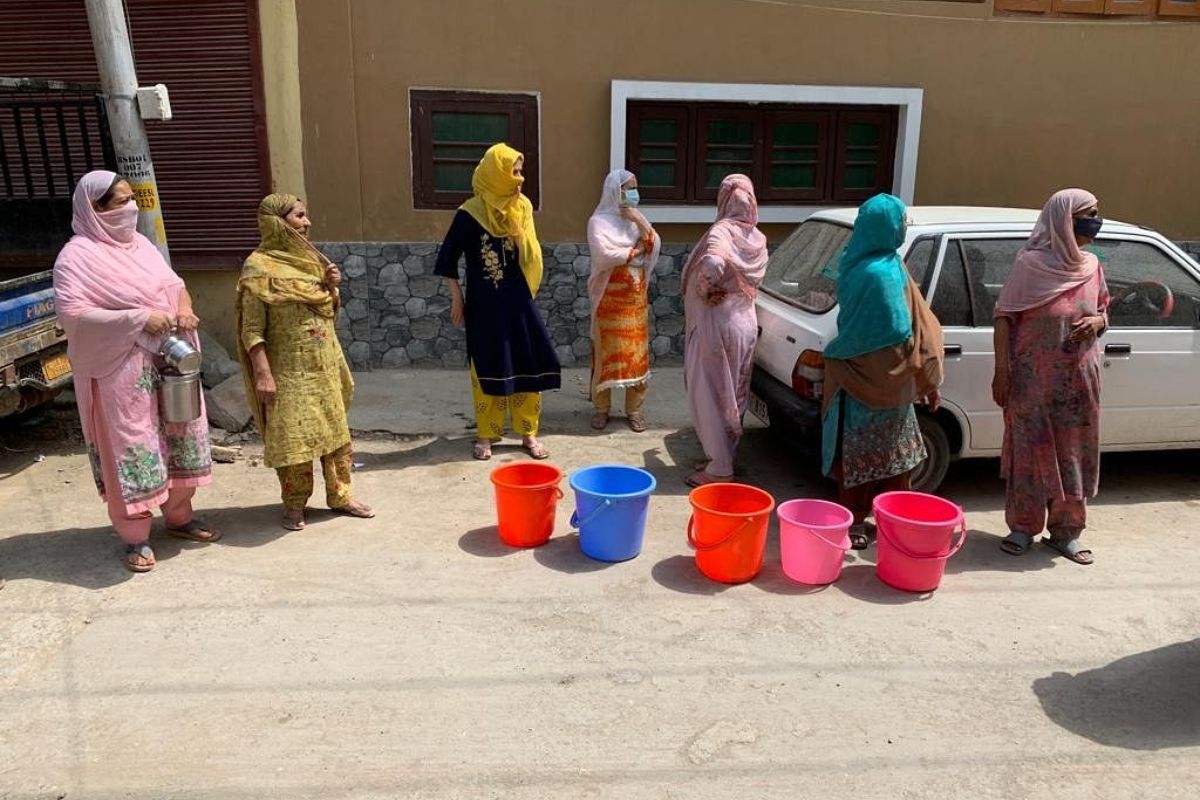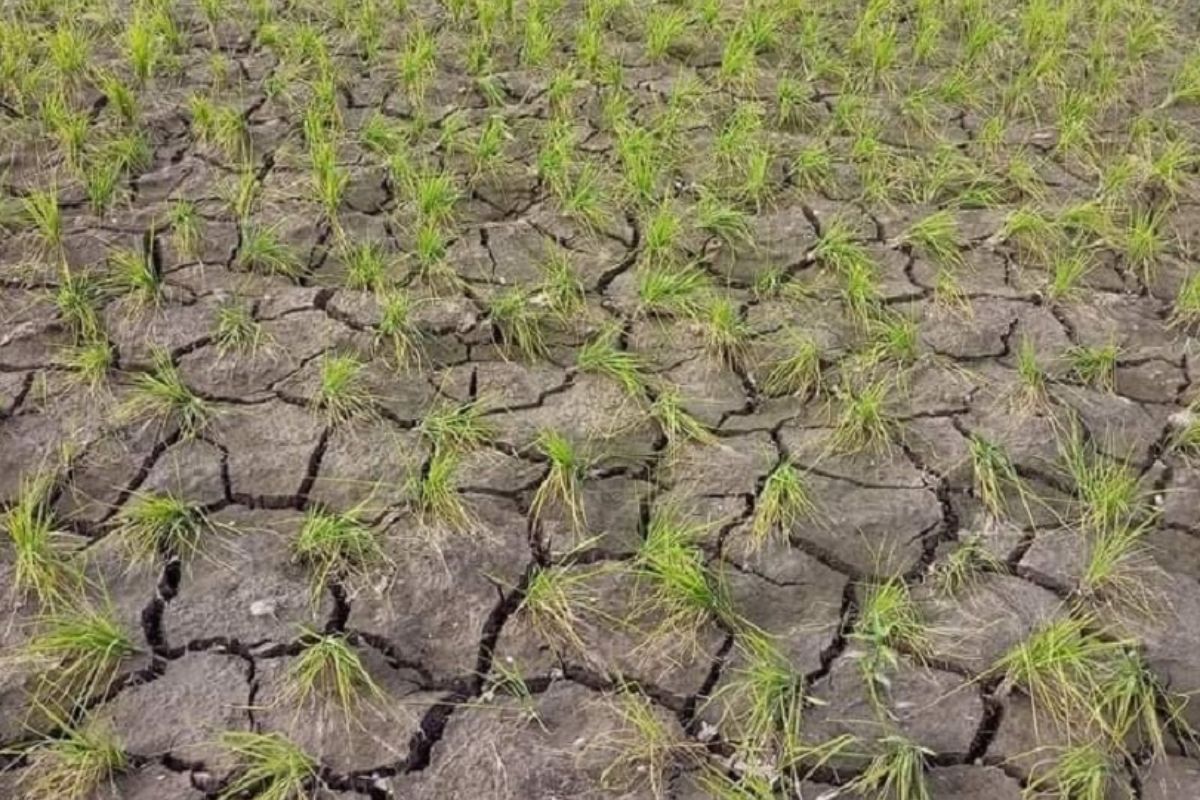Amidst a dry monsoon spell, most of Kashmir experienced a heatwave, with Srinagar reaching 35.6° Celsius in July. Srinagar was warmer than Jammu, with temperatures 5.7° Celsius above normal. Chief Engineer of Irrigation and Flood Control (I & FC) division, Braham Jyoti Sharma, said the water level in river Jhelum has reduced by 30% due to the ongoing dry spell. The two factors worsened the valley’s water scarcity, leading to public demonstrations.
The scarcity led to public demonstrations across the valley. In Sopore, Chankhan residents protested the Jal Shakti department for failing to provide a regular water supply. Similar protests erupted in Pattan, north Kashmir, where hundreds from Chenabal village blocked the Srinagar-Baramulla highway for hours.
15-20% of the valley’s drinking water is “badly affected,” said Jal Shakti department Chief Engineer Er. Vivek Kohli. The situation may worsen if the wet spell continues.
Water Shortage in Urban areas
The Jal Shakti Department reported water shortages in parts of Srinagar, especially in tail-end areas, potentially because of increased consumption, due to high temperatures. The department appealed to the public to use water judiciously, avoid waste and misuse for non-essential purposes like watering lawns, kitchen gardens, or washing vehicles, and not to use online boosters for equitable water distribution.
“Due to the prolonged dry spell, the water demand has increased, affecting the current supply,” he said. Er. Kohli said the dry spell has a greater impact in plain areas, with a significant decline in water supply.
“Discharge at isolated springs across the valley has considerably reduced, exacerbating the water scarcity,” Kohli said, adding that there is no major problem in Srinagar areas except a few remote parts of the city.

The department needs to address the increasing water shortage, especially in rural areas. Some areas have tap connections but no water, while others have no connections at all. The Jal Shakti Department had launched a mission to provide tap connections to 100% of households.
The crisis was acute in Shia areas during Muharram. A community leader in Hawal explained, “Water is crucial for our processions and ceremonies, for drinking, sprinkling, and hygiene during gatherings.”
The Chief Engineer said an emergency water supply plan has been initiated for areas facing water scarcity. “We have a contingency plan because water production depends on the availability of water in rivers and springs. However, we have mobilised all water tankers and will supply where needed,” he said.
He added that the officers in the PHE Department have been empowered to hire private water tankers if the existing fleet is insufficient. Toll-free numbers have been issued for people to report any issues.
Impact on Paddy Cultivation
The water crisis has severely impacted the agricultural sector, particularly paddy cultivation, crucial to Kashmir’s economy and food security. The unavailability of irrigation water has prevented many farmers from sowing paddy. Locals from several villages reported dried-up water resources, leading to irrigation shortage
In 2018, the Irrigation Department in Baramulla district advised farmers against paddy cultivation due to insufficient snowfall and rainfall, which led to a water shortage in the Jhelum River and other streams. Similar notices were issued in Kupwara, Bandipora, and Ganderbal districts this year. In 2022, 25% of paddy land remained uncultivated due to irrigation shortage, forcing farmers to switch to other crops. The hot spring worsened the water crisis and crop yields.
Braham Jyoti Sharma stated that almost 10% of the lift irrigation schemes are non-functional due to the prevailing situation. But, he added, “The situation isn’t alarming now, and regular meetings are being held to assess it. It’s under control!”
Farmers in south, north, and central Kashmir, especially paddy growers, worry about the prolonged dry spell. The water crisis severely affects Kashmir’s agriculture. A 64-year-old farmer Abdul Rehman Khan from Cherwan, Ganderbal, expressed concern over the lack of water in the fields. “Our paddy fields are parched; it’s unprecedented. The irrigation channels are empty, and there’s been no rainfall,” he said.

Local farmer Shabir Ahmed said, “It breaks my heart that we haven’t been able to irrigate our fields for the past 14 days. The sight of our once-healthy crops now parched and withered is overwhelming. We’ve been so devastated that we haven’t dared to visit our fields.” The crisis has forced many farmers to abandon paddy cultivation. A top agriculture official reported that about 25 percent of paddy land was affected this year due to irrigation shortages.
Farmers are converting paddy fields to orchards due to economic necessity and the need for less water-intensive crops. In just over a decade, Kashmir has lost 33,309 hectares of paddy fields due to bustling colonies with towering structures. This shift has significant implications for food security in the region. A recent study revealed a 40% deficit in food production in Kashmir, 30% in vegetable production, and a staggering 69% in oilseed production for a population of 6 million. Experts warn that if the land use change continues, Kashmir’s food grain deficit could exceed 60% in the next decade.
Climate change and reduced precipitation
In recent years, winter rainfall in Kashmir has been declining. Data from the India Meteorological Department (IMD) shows that the winter of 2021-2022 had only 262.5 mm of precipitation, a 9% deficit from the normal 288.4 mm. The previous year was even worse, with a 37% deficit between December 2020 and January 2021.
Geoscientist and Vice Chancellor of the Islamic University of Sciences and Technology Kashmir Dr Shakil Romshoo, stated that Kashmir is experiencing significant climate change impacts. “Due to prolonged dry spells, there is significantly less water in streams, and the flow is decreasing,” Romshoo said.
He noted that Kashmir is facing extreme temperatures. “The rise in minimum temperatures prevents snowfall,” he explained. “Over the past 130 years, there’s been a decline in snowfall,” he added. Snowfall has significantly reduced, with areas like Fakir Gujri in the Srinagar district now receiving about 2 feet of snow compared to 10 feet 40 years ago.
Dr Shakil Ahmad Romshoo warns that the absence of rain or snowfall will elevate pollutant levels in the Kashmir Valley, posing health risks. According to the advocacy group ActionAid’s report on climate change in Kashmir, average temperatures in the region have shown a rise of 1.45°C., while in the Jammu region, the rise is 2.3°C. The Chenab basin has experienced a 21% reduction in its glacier surface area.
Long-term solutions
As Kashmir grapples with the crisis, there’s a growing recognition of the need for immediate action and long-term strategies. The local administration has been providing emergency water supply, and deploying water tankers to the most affected areas. An official of the Jal Shakti department confirmed efforts to monitor and improve water supply.
The water crisis in Kashmir, worsened by the recent heatwave, highlights the urgent need for collective action on climate change. From farmers to policymakers, scientists to citizens, addressing this crisis requires a concerted effort at all levels.
Keep Reading
Lightning strikes leave two children without their mother in West Bengal
Lightning strikes in Odisha: Do palm trees really protect against lightning strikes?
In Jammu, lightning strikes kill livestock, compensation not adequate say shepherds
Indigenous communities in J&K struggle with increasing lightning risks to livelihoods
Follow Ground Report for Environmental News from India. Connect with us on Facebook, Twitter, Koo App, Instagram, Whatsapp and YouTube. Write us at GReport2018@gmail.com and subscribe to our free newsletter.
Don’t forget to check out our climate glossary, it helps in learning difficult environmental terms in simple language.







